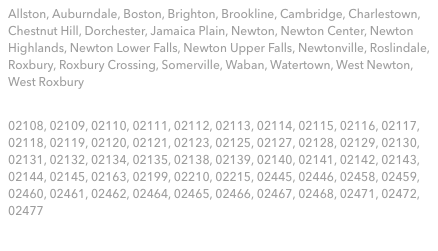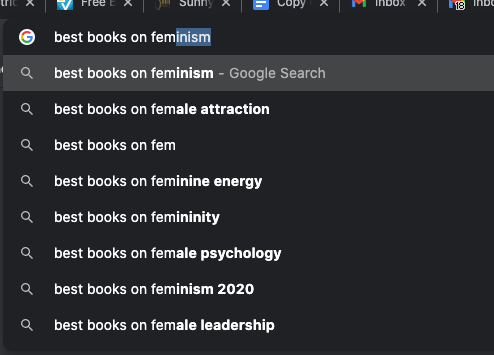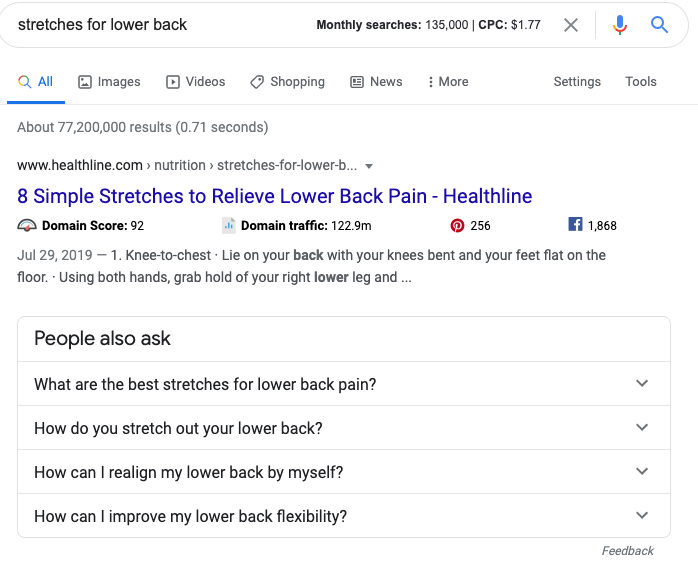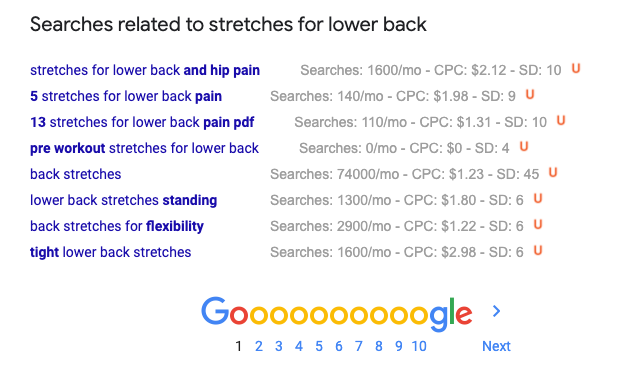The Keyword Research Strategy to Rank
Share This Post, Choose Your Platform!
The Keyword Research Strategy to Rank
Share This Post, Choose Your Platform!
Find a keyword. Cram into your blog as many times as possible. Wait for Google to pat you on the back. That’s all you need to know, right? Lolz! There was a time when keyword stuffing used to work as part of a broader keyword research strategy. And to this day, there are people and businesses who think they’re doing themselves a favor by doing things like listing every city and zip code in the area because Google will rank them for it.
If I have to see this, so do you.
Oh God! Make it stop.
Now, I want to be very clear: Keyword research isn’t dead. You still want to know the basics. And — oh, look! — I have a free guide on the basics of keyword research.
Anyway…
You’re not going to outsmart Google, so if you want to win, you have to play by the search engine’s rules.
Let’s dive right in. These are some of my best keyword research strategy tips because they go so far beyond basic keyword research and require you to do a little more digging.
For each of these keyword research tips, I’m going to (1) share the tip and then (2) explain why you need to be using it.
3 Keyword Research Strategy Tips You Haven’t Already Heard
1. Dig Into Google Suggest
You know that thing Google does where you start typing something in and the search engine auto-completes it?
I’m talking about this. ⬇️
I searched “best books on fem,” and Google completed the phrase for me.
The results that it shows are no accident. Google is showing you searches relevant to the one you’re conducting, and this is data that is has pulled from other user’s searches.
In other words, Google is telling you search terms related to yours that matter to other people using the search engine.
Um… yay?
There’s another cool trick you can use with this feature. In the above example, Google completed the end of the phrase. What if you want Google to complete a word or words in the middle of the phrase?
You can! It’s called Google Wildcard.
All you do is replace the word(s) that you want Google to complete with an asterisk, and those results will populate below. Check it out.
Pretty nifty, huh?
Why You Should Do This
There are a couple of reasons why this little tactic is so cool.
First, it’s like a handy, and free, keyword research tool. Don’t know exactly what word to be optimizing your content around? You can start searching something related to your topic, and Google will give you a bunch of ideas.
Second, if you do already have your keyword, this method can give you additional, related keywords that you might want to work into your blog. I’m talking about…
… latent semantic indexing! 👏👏👏
In a nutshell, LSI refers to words that revolve around the same topic that we can group together.
For example, let’s say our keyword is “gardening.” LSI keywords might be:
- Planting
- Horticulture
- Flowerbed
- Cultivation
Okay. Cool. Great. Why do we care?
Because Google cares. And if Google cares, you should care.
Here’s the thing. Solely focusing on picking a keyword and sprinkling it throughout the blog isn’t enough anymore. You need to do more to tell Google what your blog is about and who it’s addressing. This way, Google will know exactly how to rank you and who to show your content to.
The more “clues” you give Google, the better your content performs. And a great way to give it a clue is to use LSI keywords.
But it’s not just that. LSI keywords also force you to create content around other terms and ideas that your readers might very well care about. For example, if a reader clicks on your blog because they want to know about gardening… and in that blog, you also offer tips for how to make a flowerbed more lush… this is something your reader might really want to learn about.
You’ll give them a better experience, and THAT is what Google cares most about: user experience.
Not how many times you crammed a keyword in there.
2. Look at the Related Searches
Google’s auto-complete isn’t the only indication you get of related searches that people have conducted. The search engine goes one step further.
I want you to do something. Search “stretches for lower back.” Near the top of the results page, you’re going to see something like this.
DO YOU SEE THAT?
“People also ask.” Boom. Bam. Mic drop. 🎤
Google can’t spell it out for us any clearer. It looks at what you search and then says, “Oh! Hi! Hello! Here are some related search queries, just to make your life easier! You’re welcome!”
But wait. We’re not done. Scroll down. To the very bottom of the search results page.
Keep going. Keep going. I said scroll to the BOTTOM.
It’s just so beautiful.
Once again, Google is offering up searches related to what we just searched.
Why You Should Do This
I told you earlier that this would require a little more digging, and that’s exactly what we’re doing here. When it comes to keyword research, it’s not just about the keyword. It’s about figuring out what people want to read about when they search that keyword.
That’s why these related searches are so valuable.
When we type is “stretches for lower back,” we know that people are also interested in reading about:
- The best stretches for lower back pain.
- How to reallign their back themselves.
- How to make their lower back more flexible.
- Pre-workout stretches for lower back pain.
And so on.
So, if applicable, these are additional topics that you can cover in your own blog, when you’re optimizing it for “stretches for lower back.”
Doing so will help tell Google how to rank you. Google will increasingly show your content to people who care. The more these people spend time on your content, the better Google will continue to rank you. And round and round we go.
3. Factor in User Intent
We can take this one step further.
Let’s say you know that you want to blog about vegan cooking. And after applying the first couple of keyword research tips we’ve covered, you plan to incorporate the following ideas in your content:
- Is it ok to be vegan?
- What can vegans eat for dinner?
- Easy vegan recipes
So, you’ve got keywords. And you’ve got ideas. But that’s not enough to pump out a high-quality, highly targeted, beautiful optimized blog.
What then?
I’m so glad you asked! 🤗
There’s still more that we need to do to be sure we’re writing about things that people actually want to read about. Enter: user intent.
User intent might sound pretty self-explanatory, but let’s go over it anyway. This refers to what a person is trying to find when they search for something on Google.
“Duh!” you’re saying. But hold on there.
If someone searches “vegan cooking,” yes, we know they want to know about vegan cooking… but what about vegan cooking? That could mean a million things. What is the user’s intent?
Here’s how we find out.
If you’re writing a blog on vegan cooking, you’re going to Google that phrase. You’re going to open the first several results on page one, and you’re going to read them.
What points are they covering? What kind of information are they providing? And what specifically are they talking about?
That’s how we determine user intent. We don’t need to guess. Google flat-out tells us.
Want to learn a little more? I’ve got a video on it.
Why You Should Do This
As you know by now, you need to deliver content that people are interested in reading. And that goes beyond a simple keyword.
The reason why we examine the results of the first page of Google is that we know those pages are doing something right. After all, Google ranked them as the best.
So, instead of needing to reinvent the wheel, you can simply look at what’s already working. Use that for inspiration, and then create content that’s even better. Read: Do. Not. Copy. Copying is for losers.
I know that you might be reading this and thinking, “This is going to slow me down so much.” But don’t look at it that way. Rather, look at it as part of the process.
There’s just too much content being published every day for any of us to believe that half-arsing it and cutting corners is going to work. It’s not. If you’re going to spend time producing content, why not do it the proper way?
Put extra time into the research phase, and you’ll reap the rewards.





